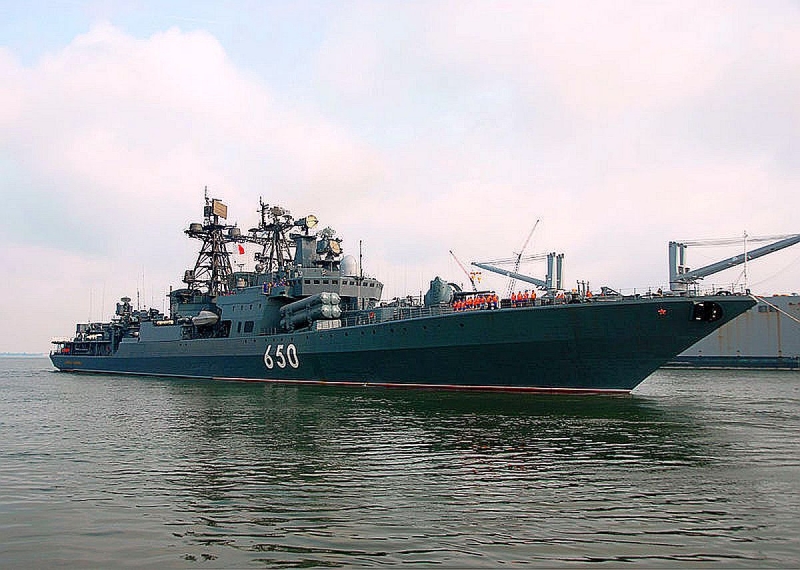NAVI MILITARI - Marina Militare Russa - Voenno Morskoj Flot Rossijskoj Federacii - Cacciatorpediniere
| Precedente Successiva |
 |
| Admiral Chabanenko |
| As per: http://www.militaryfactory.com/ships/detail.asp?ship_id=Admiral-Chabanenko-DD650 To match the American Navy's Arleigh Burke-class multi-mission, guided missile destroyers, Soviet engineers were asked to develop a modernized solution through the existing Udaloy-class ships of fighting ships in 1982. The work spawned the related "Udaloy II" class which essentially morphed the anti-submarine-minded group into an anti-ship destroyer platform. The upgraded class was given an all-new anti-ship missile suite as well as improved local defense capabilities and Fire Control System (FCS). The product of the class became Admiral Chabanenko (DD-650) while two other vessels were also planned to join her. However, the fall of the Soviet Empire heavily curtailed expansion of the program and resulted in just Chabanenko being completed. The vessel saw its keel laid down on February28th, 1989 and was launched on June 16th, 1994 before seeing formal commissioning on January 28th, 1999. Despite her Cold War roots, she continues in service with the Russian Northern Fleet today (2014). Her planned sisters - Admiral Basisty and Admiral Kucherov - were both laid down in 1991 but never completed and ultimately scrapped in 1994 and 1993 respectively, leaving the Udaloy II-class strength at just one. A key change to the Udaloy-class design to produce the Udaloy II-class was the introduction of the newer "Zvezda" M-2 series sonar system. The original pair of 100mm decks guns was replaced by a twin-gunned 130mm AK-130 installation at the forecastle to provide improved medium-ranged defense against inbound surface threats. The RBU-Udav anti-torpedo suite (twin launchers) increased the ship's standard survivability in the face of emerging submarine threat capabilities from the West and the original anti-submarine SS-N-14 "Silex" anti-submarine missiles were given up in favor of the SS-N-22 "Sunburn" missile for engaging surface threats at range. Torpedo launch tubes were held near amidships. Aerial threats were countered through an 8 x 8 bank of SA-N-9 "Gauntlet" surface-to-air missiles in a Vertical Launch System (VLS) arrangement. Close-in defense was aided through 4 x 6 30mm AK630 Close-In Weapon Systems (CIWSs) Gatling-style cannon suitable for engaging incoming aerial threats including cruise missiles. Power for the vessel came through a conventional gas turbine arrangement - this carried over from the original class and essentially made up of 4 x gas turbines in a COmbined Gas and Gas (COGAG) arrangement feeding 2 x shafts at 120,000 horsepower. COGAG mated two gas turbines to a single shaft, allowing a gearbox to arrange drive power from either one or both of the turbines depending on the amount of power required. In this way, the vessel could utilize either two or all four of its turbines at any one time to accomplish general cruising or short, speedy dashes. Maximum speed in ideal conditions could therefore reach 35 knots with a service range out to 10,500 nautical miles (12,100 miles). The profile of the Admiral Chabanenko became typical of the Udaloy class with an uneven superstructure design showcasing relatively low profile mast works. The forecastle was home the turreted 130mm deck gun and two banks of two cylindrical, horizontally-mounted launchers identified just ahead of the bridge superstructure. Between the launchers was the Vertical Launch System (VLS). The bridge itself was identified y its large rectangular windows along the front and sides of its design. The various masts contain the equally various communications and sensor arrays required for optimal ship service over vast ocean spaces. At amidships were the two paired mounts of low-profile smoke funnels. A full-service helicopter deck and hangar was added over the stern and supported up to 2 x Kamov naval helicopters in the ASW, Search and Rescue (SAR), or transport roles. The standard operation crew of the vessel was listed at around 300 personnel. Dimensions included a length of 163 meters, a beam of 19.3 meters, and a draught of 6.2 meters. Displacement values reached 6,930 tons under standard load and 7,570 tons under full load. Thus far the only notable action pertaining to the Admiral Chabanenko was its passing of the Panama Canal during 2008, marking the first time that a Russian Fleet warship had passed that part of the globe since the fighting of World War 2 (1939-1945). |
| Username | |
| Armatore | Voenno Morskoj Flot Rossijskoj Federacii |
| Ship manager | |
| Numero IMO | |
| Classificazione | Destroyer |
| Cantiere e anno di costruzione | 1999 |
| Data | |
| Luogo | |
| Aggiunta il | 04/03/2017 |
| Dimensioni | 1200 x 855 |
| visite | 1156 |
















